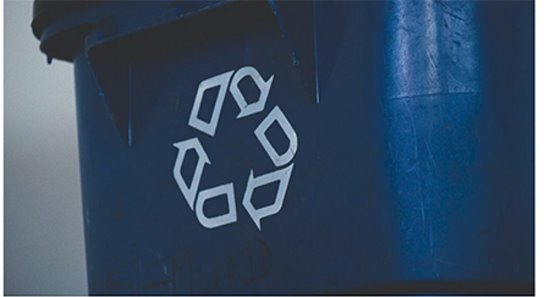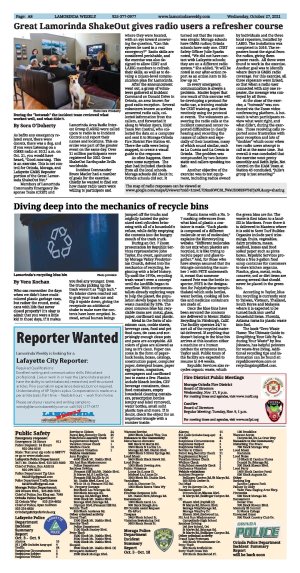| | Published October 27th, 2021
| Diving deep into the mechanics of recycle bins
| | | By Vera Kochan |  | | Lamorinda's recycling blue bin Photo provided |
Who can remember the days when we didn't have multi-colored plastic garbage cans, but rather the round, metal cans with lids that never closed properly? It's okay to admit that you were a little kid in those days, if it makes you feel any younger. Even the trucks picking up the trash weren't as "high tech." No lobster claws reached out to grab your trash can and flip it upside down, giving the receptacle an additional shake to make sure the contents have been emptied. Instead, actual human beings jumped off the trucks and mightily hoisted the galvanized steel cylinders brimming with all of a household's refuse, while deftly emptying the contents into the hungry mouth of the trash truck.
 During an Oct. 7 Zoom presentation by Republic Services representative John Taylor, the event, sponsored by Moraga Valley Presbyterian Church, delved into the mechanics of recycling, beginning with a brief history. Up until the 1970s, recycling trash wasn't even a concept until the landfills began to overflow. With environmentalists already exploring ways to help the planet, the population slowly began to reduce waste material by 52%. The most common blue bin recyclable items are: metal, glass, paper, cardboard and plastic.
During an Oct. 7 Zoom presentation by Republic Services representative John Taylor, the event, sponsored by Moraga Valley Presbyterian Church, delved into the mechanics of recycling, beginning with a brief history. Up until the 1970s, recycling trash wasn't even a concept until the landfills began to overflow. With environmentalists already exploring ways to help the planet, the population slowly began to reduce waste material by 52%. The most common blue bin recyclable items are: metal, glass, paper, cardboard and plastic.
 Metal in the form of aluminum cans, cookie sheets, beverage cans, food and pet food cans, tin cans and surprisingly enough clean pots and pans are acceptable. All colors of glass are allowed as long as it's clean. Paper can come in the form of paperback books, boxes, catalogs, construction paper, computer paper, detergent boxes, paper egg cartons, magazines, newspapers and cardboard just to name a few. Plastics include bleach bottles, CRV beverage containers, clean food containers, empty household cleaning containers, prescription bottles (empty and label removed), water bottles, small solid plastic toys and more. If in doubt, check the object for an imprinted triangle with a number inside.
Metal in the form of aluminum cans, cookie sheets, beverage cans, food and pet food cans, tin cans and surprisingly enough clean pots and pans are acceptable. All colors of glass are allowed as long as it's clean. Paper can come in the form of paperback books, boxes, catalogs, construction paper, computer paper, detergent boxes, paper egg cartons, magazines, newspapers and cardboard just to name a few. Plastics include bleach bottles, CRV beverage containers, clean food containers, empty household cleaning containers, prescription bottles (empty and label removed), water bottles, small solid plastic toys and more. If in doubt, check the object for an imprinted triangle with a number inside.
 Plastic items with a No. 1-7 marking references from what kind of plastic a container is made. "Each plastic is composed of a different molecule or set of molecules," explains the Rlmrecycling website. "Different molecules do not mix when plastics are recycled, it is like trying to recycle paper and glass together." And, for those who have always assumed that the triangle containing the number 1 with PETE underneath it, meant that someone named Pete was the bottle inspector, PETE is the designation for Poly(ethylene terephthalate) which soda bottles, water bottles, cooking oil bottles and medicine containers are made of.
Plastic items with a No. 1-7 marking references from what kind of plastic a container is made. "Each plastic is composed of a different molecule or set of molecules," explains the Rlmrecycling website. "Different molecules do not mix when plastics are recycled, it is like trying to recycle paper and glass together." And, for those who have always assumed that the triangle containing the number 1 with PETE underneath it, meant that someone named Pete was the bottle inspector, PETE is the designation for Poly(ethylene terephthalate) which soda bottles, water bottles, cooking oil bottles and medicine containers are made of.
 Once the blue bins have been serviced the contents are delivered to Mount Diablo Recycling in Pittsburgh, Calif. The facility operates 24/7 to sort all of the recycled material delivered. If anything that doesn't belong in the blue bin arrives at this location either a machine or a human catches the erroneous item, Taylor said. Public tours of the facility are expected to resume in 6-8 weeks.
Once the blue bins have been serviced the contents are delivered to Mount Diablo Recycling in Pittsburgh, Calif. The facility operates 24/7 to sort all of the recycled material delivered. If anything that doesn't belong in the blue bin arrives at this location either a machine or a human catches the erroneous item, Taylor said. Public tours of the facility are expected to resume in 6-8 weeks.
 Republic Services also recycles organic waste, which the green bins are for. The waste is first taken to a landfill in Martinez. From there it is delivered to Manteca where it is sold to Scott Turf Builder. Organics include yard trimmings, fruits, vegetables, dairy products, meats, seafood, bones and food soiled paper such as pizza boxes. Republic Services provides a free 3-gallon food scrap container for customers to store kitchen organics. Plastics, glass, metal, rocks, concrete, sod or dirt items are among several that should never be placed in the green bin.
Republic Services also recycles organic waste, which the green bins are for. The waste is first taken to a landfill in Martinez. From there it is delivered to Manteca where it is sold to Scott Turf Builder. Organics include yard trimmings, fruits, vegetables, dairy products, meats, seafood, bones and food soiled paper such as pizza boxes. Republic Services provides a free 3-gallon food scrap container for customers to store kitchen organics. Plastics, glass, metal, rocks, concrete, sod or dirt items are among several that should never be placed in the green bin.
 According to Taylor, blue bin recycling is currently sent to Taiwan, Vietnam, Thailand, South Korea and Malaysia where it is expected to be turned back into useful household items. Phoenix, Arizona turns its plastic waste into fuel.
According to Taylor, blue bin recycling is currently sent to Taiwan, Vietnam, Thailand, South Korea and Malaysia where it is expected to be turned back into useful household items. Phoenix, Arizona turns its plastic waste into fuel.
 The book "Zero Waste Home: The Ultimate Guide to Simplifying Your Life By Reducing Your Waste" by Bea Johnson, has helpful pointers for waste-free living. Additional recycling tips and information can be found at: www.republicservices.com or www.recyclingsimplified.com.
The book "Zero Waste Home: The Ultimate Guide to Simplifying Your Life By Reducing Your Waste" by Bea Johnson, has helpful pointers for waste-free living. Additional recycling tips and information can be found at: www.republicservices.com or www.recyclingsimplified.com. |
| | | | | | | | | | | | |



